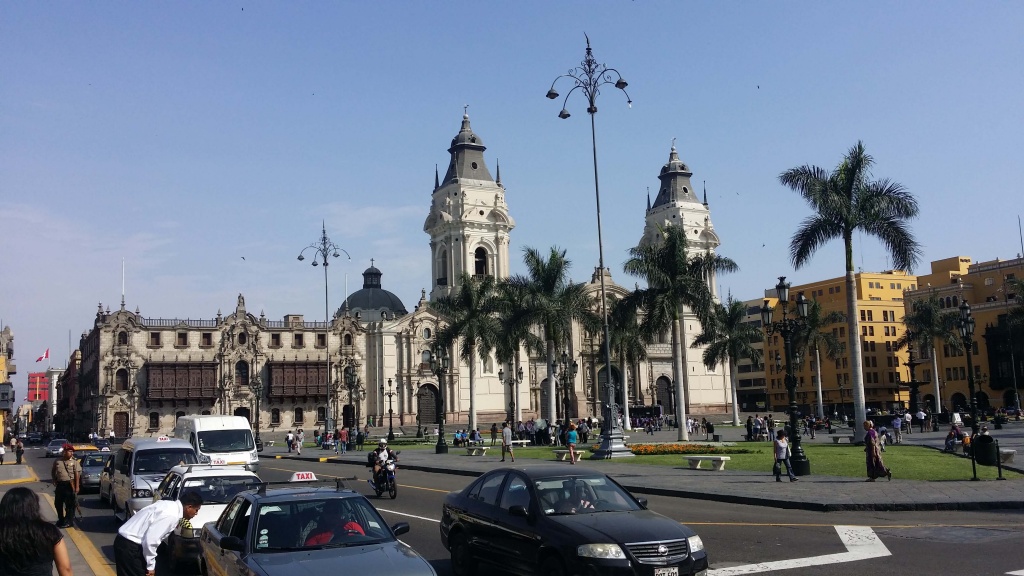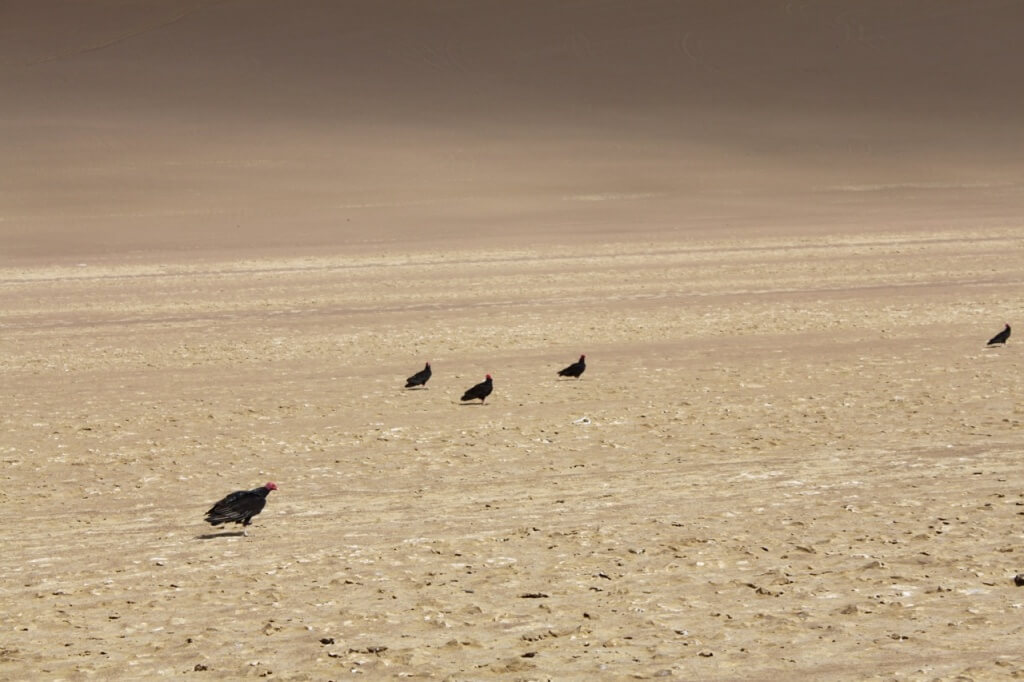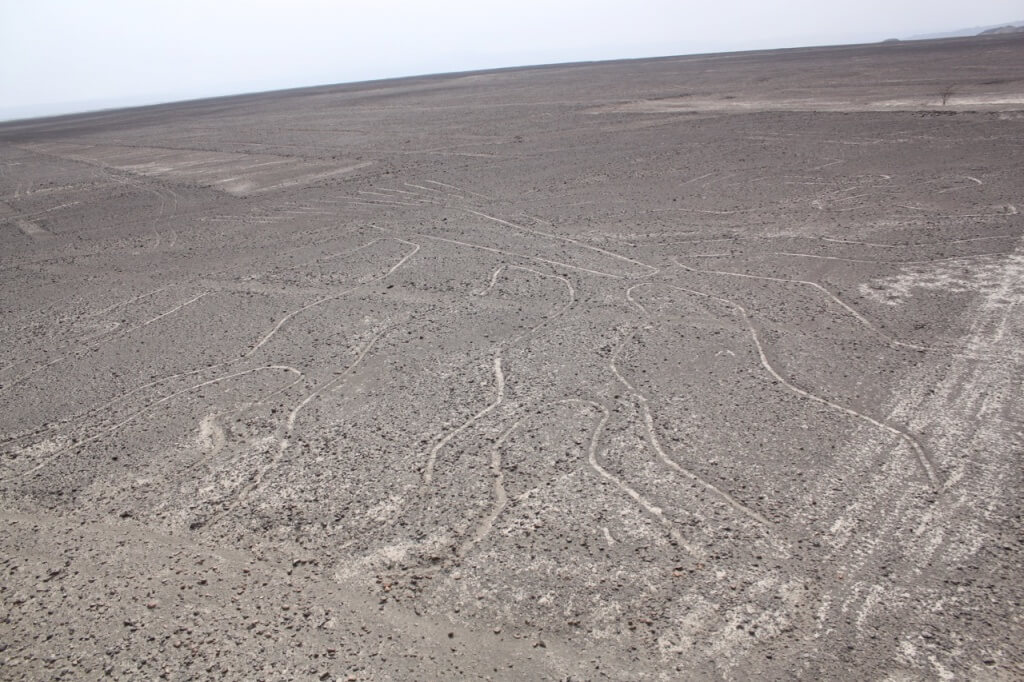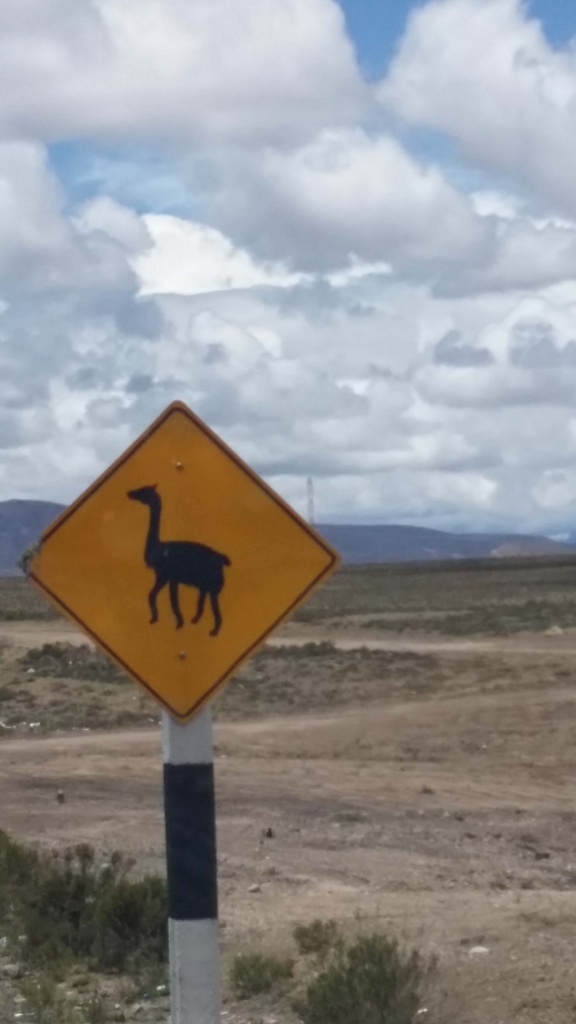Well, down from the mountains we went. We left the pleasant cool of the Andes and returned to the heat of the coastal Peru desert. And boy was it hot. It doesn’t help when you’re alternating between the 80-90 degree coast to the 40 degree mountains.
Very soon, we were in bleak rock mountains, going down the road, with a valley of desert ahead split by a river. Around us glared the presidential candidates’ logos; the parties’ names all painted on every available surface. Be it a wall, someone’s house, or even the cliff faces themselves, the names were everywhere: PPK, KEIKO, GUZMAN, TOLEDO, ACUNA, etc. Imagine that every house, fence, wall, and building had either an elephant or a donkey painted on it in bright, lurid red or blue and you’d have an idea about what we saw everywhere in Peru.
We found a nice hotel that looked liked it was covered in bathroom tiles. The room was good though, there was a pleasant breeze, and the Internet was good. We slept well.
On the road to Lima, we drove along the coast, passing the occasional 18-wheeler. It was a relatively nice view of the ocean, with birds flying by, only marred by the trash piles here and there. We began to slow down nine or ten miles from Lima, with the road becoming a four-lane highway but at the same time filling up with buses, trucks, vans, and cars. We drove through the crazy, aggressive streets; everyone uses the horn, and turns are announced with last-minute signals, a honk, and the sound of a rapidly accelerating engine, making you slam on your brakes or risk a crash. Somehow, it all works to some extent, as we got through safely and arrived to the Miraflores neighborhood.
While most of the rest of Lima we saw was grimy, dirty, and a little scruffy-looking, the Miraflores neighborhood is clean, fancy, and looks very similar to Santa Monica. It is clear there is money in the neighborhood, in the fancily designed apartments featuring large glass windows, large houses with plaza-like yards, a park with a view of the sea, and all a manner of nice cafes and restaurants that you might see in Seattle or L.A., just with more American names.
We found a nice hostel that could actually fit us (thanks, iOverlander) and once we’d settled, cracked out the math homework. We left after several hours to a ‘chifa’ that had been recommended to us, a Chinese restaurant. (There are a lot of Chinese immigrants in Peru). We hadn’t had Chinese food in six months, since Seattle, so it was very, very good to eat there. It was also strange to see Asian-looking people speaking Spanish, as you don’t really picture it in your head.
Lima’s Plaza de Armas was a huge, very pretty square. At the end, the government palace dominated the view. To its right, the Archbishop’s palace and Cathedral of Lima each shared a side, fighting each other for the grandest, most impressive buildings. The center of the plaza was home to lots of benches, grass patches, and a huge fountain.
We climbed the stairs to the Cathedral of Lima and went to go in, only to learn you needed to pay. Great. We said thanks and walked over to the Archbishop’s palace, only to learn you needed to pay there too! We talked it over, and decided that we might as well go in.
It was very interesting. The first floor featured paintings mostly dedicated to the Virgin Mary, with the occasional Jesus. Also interesting were the display cases full of Archbishop’s gold. I’m probably not the one to question the Archbishop, but isn’t Christianity all about giving? Regardless it was pretty.
The second floor featured the Archbishop’s living area and a prayer hall. Another question: does the Archbishop, a single guy, really need that many living rooms? Cause if so, sign me up! But in all seriousness, the man had a good six small living rooms, a single, huge living room, and a large dining room. For a single man! After looking through the house, we went to the prayer hall and sat for a while, but finally decided to leave.
We walked around the plaza before taking a pedestrian road down to a smaller plaza. It was littered with all a manner of shops, including a Starbucks that was completely empty. We got ice cream, and upon reaching the second plaza, found a taxi and headed back to the hostel.
That night we went to Mango’s, a nice restaurant. We all put on our niceish clothes to go. We walked to the restaurant, and the waiter found us a table. He was very nice and friendly, joking around with us. Our meal was tasty; the appetizer had stuffed potatoes, a super tender beef kebab thingy that was absolutely delicious, and a small Peruvian tamale with meat and olives. The main meal was equally tasty; I got Pescado al Mango, fish with a great sauce, shrimp, and 2 crab claws with a little nip of crabmeat. Nate got a shrimp risotto that was our favorite plate of the four. Mom got a swordfish fillet that was a tiny bit overcooked but still good, and Amelia got a beef plate with a ton of french fries. I had two milkshakes, Amelia two lemonades, and Mom and Nate pisco sours. For desert we got a warm and delicious volcano cake and a cheesecake. It was really good and a fun night.
Early next morning, we left Lima and headed to a nearby national park called Paracas, home to (supposedly) seals and penguins!
On the drive there, we were surprised and entertained by the huge, custom made billboards, and we deduced that this was the direction all the rich Miraflorians drive.
We went to the edge of the park, to the coast. The first thing we noticed was the smell; it stank vaguely of urine. Then we saw the brown water. Well, I guess we might know were Lima’s sewage goes. There were still lots of seabirds, and though we didn’t see penguins, we did see seals… and flamingos!
The next day we left to Nazca, the town home to the Nazca Lines. It was more hot desert driving, as we left the coast and its breeze. We couldn’t do the plane ride that showed off all the lines, as it was 85 dollars a person, but we did go to an observatory were we could see two. I won’t say much about the lines incase you want to go see them yourself, but they weren’t nearly as impressive as I thought they would be.
Where we stayed the night was much cooler in my opinion. Necropolis Chauchilla was a bunch of pre-Inca tombs with mummies in them. The walkway you went on had the occasional bone to its left or right. The mummies themselves were very well preserved, and were buried with all sorts of goods. We made dinner for and played cards with the guard that night. We also saw a scorpion running around.
The next day was a tough one: a straight drive from Nazca to Arequipa. It was a long one; it was supposed to be eight hours, but ended up being ten. We drove a good 200 miles that day.
Once we reached Arequipa, we did some homework before walking to a supermarket to eat at its food court. It was ok; had we been less tired and hungry, it probably would have not been that good. The hotel itself, even though we were only camping, was very nice. It looked like an old mansion, with antique furniture, all sorts of paintings, and just the feel and smell of an old mansion. We think it had been some Spaniard’s villa way before the highway had been built, and that his grandson or great-grandson had sold it once the road was there.
In Arequipa, we circled around the plaza’s general vicinity, walking down one road before turning back, then walking down a different road. We got ice cream – Nate and Mom got the queso helado, the traditional ice cream made with milk, sugar and cinnamon. A word on Arequipa’s main square: the small, black, biting flies are absolutely vicious. You need to spray a heck of a lot of repellant, or be eaten alive.
After several hours, we went to a restaurant called Hatunpa, a cool place that features potatoes: you get a bed of potatoes with a topping: chicken, veggies, alpaca…. It was very, very good, and reasonably priced, too. The owner and waitress was very nice and good at her job.
The road to Tinajani Canyon, our campground for the night, was very interesting. We crossed the altiplano, a plateau at around 4,500 m., which is surrounded by huge peaks. We saw vicuñas, the semi-rare ancestor of the alpaca whose fur sells for 200 dollars for a pound, and flamingos, white from not eating shrimp.
At Tinajani Canyon, at a place we won’t disclose, we saw some pre-Inca ruins, as well as more flamingos. And right before arriving to Cusco, we even saw a double rainbow.























What a treat to wake up this morning to Benjamin’s blog entry. Smelled the smells, felt the heat, saw the sights, delighted in the food. Thanks for the continuing updates!